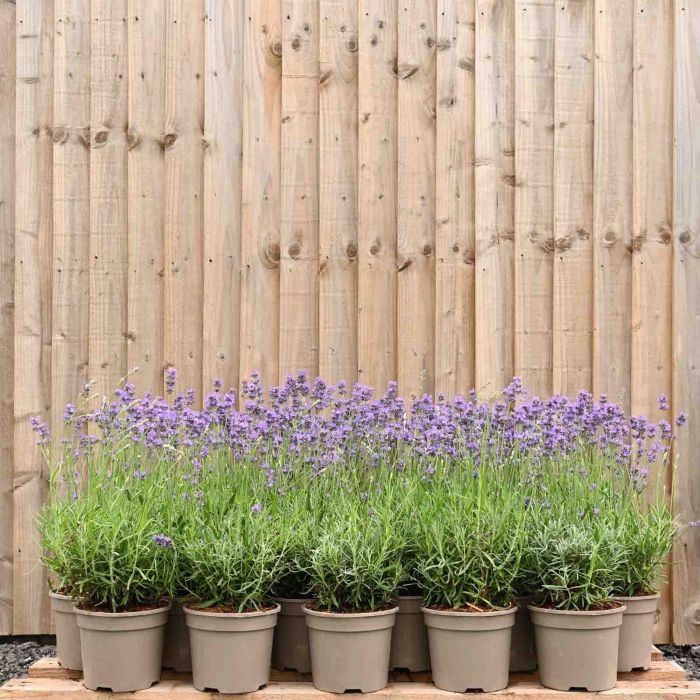
Lavender - Hidcote 20/30cm 5L pot x 30 Lavandula angustifolia Hidcote
In stock


Other Lavender 'Hidcote' Hedge plants
Key Features
EVERGREEN
NATIVE
AVERAGE GROWING
HAS FLOWERS (Purple)
Seasonal Availablity
- JAN
- FEB
- MAR
- APR
- MAY
- JUN
- JUL
- AUG
- SEP
- OCT
- NOV
- DEC
Hidcote Lavender Hedge Plants Description
Lavender 'Hidcote' is a hardy variety of Lavender native to the British Isles and is incredibly fragrant with vivid purple flowers that are a magnet for bees and other pollinators. This makes them an ideal companion to your fruit trees or garden veg patch.This variety grows to about 50cm and is included in our low growing section alongside a selection of alternative species.
Being an English variety (although not to be confused with English Lavender 'Munstead'), Lavender 'Hidcote is perfectly suited to UK gardens, making them very easy to grow in order achieve a classic English Cottage Garden appearance.
When set against the other main variety of British Lavender, English 'Munstead', Lavender 'Hidcote' has darker purple flower spikes, with a bolder colour of foliage that is equally as fragrant. Combine with other hedge species with flowers and fragrant hedging to create a vivid treat for the senses in your garden!
Lavender prefers full sun, ideally south or west facing. It is suitable for poor or moderately fertile, well drained alkaline soil. Once established they are drought tolerant and they certainly do not like to be waterlogged or to sit in wet soil - plant on a soil ridge to avoid roots sitting in wet soil. Tolerant of seaside weather conditions. See also our range of hedging for exposed sites.
The practicality of Lavender Hidcote makes this wonderful shrub a popular alternative to Box hedging when the planting site may be susceptible to box blight.
Hidcote Lavender are available all year round - plants bought in autumn, winter or spring will flower in the first summer.
Whilst Lavender Hidcote is a popular variety of Lavender hedging, we do also have the following additional varieties for sale - English Lavender, French Lavender, White Lavender, and Dwarf Lavender.
Additionally we now stock a series of specially selected Lavender Collections within our Garden plants range featuring several English and French Lavender varieties plus a special mixed variety pack.
Is Hidcote Lavender Evergreen?
All lavender varieties are technically classed as evergreen, as in warmer climates they retain their grey-green foliage year round. However, the cooler UK climate means Lavender starts to lose its flowers in August and plants go into dormancy from early autumn until late spring. During dormancy the foliage turns brown and twiggy, appearing to die back. This is perfectly normal and as the weather warms in late spring, your Lavender plant will once again become green with new shoots.
Vital Plant Information
Reviews
Plant Guarantee
Hedges Direct always supplies quality plants, however we know that sometimes plants have a mind of their own. With the Hedges Direct Green Guarantee, we've got you covered. Our 12-month guarantee is our 100% promise to you, that you can buy with complete confidence, that if any plants fail within 12 months, we will replace them when the guarantee conditions are met.
-
Step 1
Root Grow & Fertiliser
Ensure you buy root grow and fretiliser with your plants at the time of purchase
-
Step 2
Prepare Your Planting Area
Make sure your planting area is in good condition and suitable for planting
-
Step 3
Plant & Feed
Plant with root grow & the second feed. Support plants if necessary. Water regularly
You May Need
Pruning Advice
Lavender Hidcote is very easy to cultivate but the key to its longevity is pruning. Aside from regular deadheading through the growing season to encourage flower production, a proper prune should be done as soon as the flowers start to fade in August. We recommend removing at least one third of the plant, not just the flower spikes. This allows light to penetrate into the heart of the plant after which small shoots will then grow a further 5cm before the plants start to go dormant in September.
Pruning in this way ensures that your Lavender Hidcote plants have a lush, tidy appearance through winter. Once spring comes, the new shoots wil re-commence their growth giving you a dense shrub and healthy production of flowers as the weather warms.
Alternatively, you can leave the spent flower heads on the plants until spring because in winter, when food for birds is scarce, birds will come to feed on the seeds - goldfinches in particular! Plants might eventually become wooded and straggly so it is best to replace a hedge after about 20 years though this is not always necessary.
Lavender and Dormancy
It's important to note that when Lavender goes into dormancy from early autumn until late spring, it will become brown and twiggy .This is perfectly normal and it will become green again in the spring. Read our Hedges Direct Lavender Guide for more advice and information.
 Hedges Direct
Hedges Direct 










